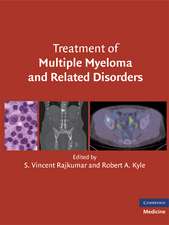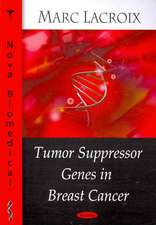Checkpoint Controls and Cancer: Volume 2: Activation and Regulation Protocols: Methods in Molecular Biology, cartea 281
Editat de Axel H. Schönthalen Limba Engleză Paperback – 19 noi 2010
| Toate formatele și edițiile | Preț | Express |
|---|---|---|
| Paperback (2) | 717.00 lei 6-8 săpt. | |
| Humana Press Inc. – 10 noi 2010 | 717.00 lei 6-8 săpt. | |
| Humana Press Inc. – 19 noi 2010 | 721.19 lei 6-8 săpt. | |
| Hardback (2) | 728.69 lei 6-8 săpt. | |
| Humana Press Inc. – 24 iun 2004 | 728.69 lei 6-8 săpt. | |
| Humana Press Inc. – 4 iun 2004 | 729.82 lei 6-8 săpt. |
Din seria Methods in Molecular Biology
- 9%
 Preț: 791.59 lei
Preț: 791.59 lei - 23%
 Preț: 598.56 lei
Preț: 598.56 lei - 20%
 Preț: 882.95 lei
Preț: 882.95 lei -
 Preț: 252.04 lei
Preț: 252.04 lei - 5%
 Preț: 802.69 lei
Preț: 802.69 lei - 5%
 Preț: 729.61 lei
Preț: 729.61 lei - 5%
 Preț: 731.43 lei
Preț: 731.43 lei - 5%
 Preț: 741.30 lei
Preț: 741.30 lei - 5%
 Preț: 747.16 lei
Preț: 747.16 lei - 15%
 Preț: 663.45 lei
Preț: 663.45 lei - 18%
 Preț: 1025.34 lei
Preț: 1025.34 lei - 5%
 Preț: 734.57 lei
Preț: 734.57 lei - 18%
 Preț: 914.20 lei
Preț: 914.20 lei - 15%
 Preț: 664.61 lei
Preț: 664.61 lei - 15%
 Preț: 654.12 lei
Preț: 654.12 lei - 18%
 Preț: 1414.74 lei
Preț: 1414.74 lei - 5%
 Preț: 742.60 lei
Preț: 742.60 lei - 20%
 Preț: 821.63 lei
Preț: 821.63 lei - 18%
 Preț: 972.30 lei
Preț: 972.30 lei - 15%
 Preț: 660.49 lei
Preț: 660.49 lei - 5%
 Preț: 738.41 lei
Preț: 738.41 lei - 18%
 Preț: 984.92 lei
Preț: 984.92 lei - 5%
 Preț: 733.29 lei
Preț: 733.29 lei -
 Preț: 392.58 lei
Preț: 392.58 lei - 5%
 Preț: 746.26 lei
Preț: 746.26 lei - 18%
 Preț: 962.66 lei
Preț: 962.66 lei - 23%
 Preț: 860.21 lei
Preț: 860.21 lei - 15%
 Preț: 652.64 lei
Preț: 652.64 lei - 5%
 Preț: 1055.50 lei
Preț: 1055.50 lei - 23%
 Preț: 883.85 lei
Preț: 883.85 lei - 19%
 Preț: 491.88 lei
Preț: 491.88 lei - 5%
 Preț: 1038.84 lei
Preț: 1038.84 lei - 5%
 Preț: 524.15 lei
Preț: 524.15 lei - 18%
 Preț: 2122.34 lei
Preț: 2122.34 lei - 5%
 Preț: 1299.23 lei
Preț: 1299.23 lei - 5%
 Preț: 1339.10 lei
Preț: 1339.10 lei - 18%
 Preț: 1390.26 lei
Preț: 1390.26 lei - 18%
 Preț: 1395.63 lei
Preț: 1395.63 lei - 18%
 Preț: 1129.65 lei
Preț: 1129.65 lei - 18%
 Preț: 1408.26 lei
Preț: 1408.26 lei - 18%
 Preț: 1124.92 lei
Preț: 1124.92 lei - 18%
 Preț: 966.27 lei
Preț: 966.27 lei - 5%
 Preț: 1299.99 lei
Preț: 1299.99 lei - 5%
 Preț: 1108.51 lei
Preț: 1108.51 lei - 5%
 Preț: 983.72 lei
Preț: 983.72 lei - 5%
 Preț: 728.16 lei
Preț: 728.16 lei - 18%
 Preț: 1118.62 lei
Preț: 1118.62 lei - 18%
 Preț: 955.25 lei
Preț: 955.25 lei - 5%
 Preț: 1035.60 lei
Preț: 1035.60 lei - 18%
 Preț: 1400.35 lei
Preț: 1400.35 lei
Preț: 721.19 lei
Preț vechi: 759.15 lei
-5% Nou
Puncte Express: 1082
Preț estimativ în valută:
138.00€ • 144.45$ • 114.86£
138.00€ • 144.45$ • 114.86£
Carte tipărită la comandă
Livrare economică 01-15 aprilie
Preluare comenzi: 021 569.72.76
Specificații
ISBN-13: 9781617376030
ISBN-10: 1617376035
Pagini: 358
Ilustrații: XVIII, 358 p.
Dimensiuni: 152 x 229 x 21 mm
Greutate: 0.55 kg
Ediția:Softcover reprint of hardcover 1st ed. 2004
Editura: Humana Press Inc.
Colecția Humana
Seria Methods in Molecular Biology
Locul publicării:Totowa, NJ, United States
ISBN-10: 1617376035
Pagini: 358
Ilustrații: XVIII, 358 p.
Dimensiuni: 152 x 229 x 21 mm
Greutate: 0.55 kg
Ediția:Softcover reprint of hardcover 1st ed. 2004
Editura: Humana Press Inc.
Colecția Humana
Seria Methods in Molecular Biology
Locul publicării:Totowa, NJ, United States
Public țintă
ResearchCuprins
Protocols for the Study of Checkpoint Regulatory Components.- Analysis of RB Action in DNA Damage Checkpoint Response.- Interaction Between the Retinoblastoma Protein and Protein Phosphatase 1 During the Cell Cycle.- Generation of p53 Target Database Via Integration of Microarray and Global p53 DNA-Binding Site Analysis.- Functional Analysis of CDK Inhibitor p21WAF1.- Analysis of p21CDKN1A Recruitment to DNA Excision Repair Foci in the UV-Induced DNA Damage Response.- Quantitative Determination of p16 Gene Expression by RT-PCR.- Measuring Cyclin-Dependent Kinase Activity.- Determination of the Catalytic Activities of mTOR and Other Members of the Phosphoinositide-3-Kinase-Related Kinase Family.- CHK1 Kinase Activity Assay.- Assaying Cdc25 Phosphatase Activity.- Analyzing the Regulation and Function of ATM.- Use of siRNA to Study the Function of MDC1 in DNA Damage Responses.- Functional Analysis of APC-Cdh1.- Purification of the Mitotic Checkpoint Complex, an Inhibitor of the APC/C From HeLa Cells.- Analysis of the Spindle-Assembly Checkpoint in HeLa Cells.- Functional Analysis of the Spindle-Checkpoint Proteins Using an In Vitro Ubiquitination Assay.- Studying Consequences of Checkpoint Pathway Activation.- Analysis of Checkpoint Responses to Histone Deacetylase Inhibitors.- Biochemical Analysis of the Cell Cycle and Cell Cycle Checkpoints in Transiently Transfected Cells After Collection With Magnetic Beads.- Analysis of DNA Repair and Chromatin Assembly In Vitro Using Immobilized Damaged DNA Substrates.- Analyzing Cell Cycle Checkpoints After Ionizing Radiation.- FACS-Based Detection of Phosphorylated Histone H3 for the Quantitation of Mitotic Cells.- Analysis of Cell Cycle by Flow Cytometry.- Analyzing Markers of Apoptosis In Vitro.- Analysis of Telomerase Activity and Telomere Function in Cancer.
Textul de pe ultima copertă
Intracellular checkpoint controls constitute a network of signal transduction pathways that protect cells from external stresses and internal errors by means of cell cycle arrest, DNA repair, or apoptosis. Failure of this machinery can lead to embryonic death, genetic diseases, and cancer. In Checkpoint Controls and Cancer, Volume 2: Activation and Regulation Protocols, Axel H. Schönthal, PhD, marshals a prestigious panel of researchers working at the cutting edges of their fields to present readily reproducible experimental protocols for the study of the molecular components of checkpoint controls and their regulation. Described in step-by-step detail, these powerful techniques offer such novel approaches as the use of genome databases and siRNA to analyze how cells of the human body can escape proper surveillance to grow into a tumor. Additional experimental methods are provided for the manipulation of checkpoint pathways and the analysis of the resulting consequences for the cellular phenotype. The earlier first volume, Reviews and Model Systems, comprehensively describes the complexities of checkpoint controls and the model systems available to study them.
Comprehensive and up-to-date, the two volumes of Checkpoint Controls and Cancer offer novice and experienced researchers alike not only entré into the complexities of this vast field, but also to the full panoply of productive tools needed to deepen understanding of the systems, as well as to develop new and more effective therapies.
Comprehensive and up-to-date, the two volumes of Checkpoint Controls and Cancer offer novice and experienced researchers alike not only entré into the complexities of this vast field, but also to the full panoply of productive tools needed to deepen understanding of the systems, as well as to develop new and more effective therapies.
Caracteristici
Includes supplementary material: sn.pub/extras














